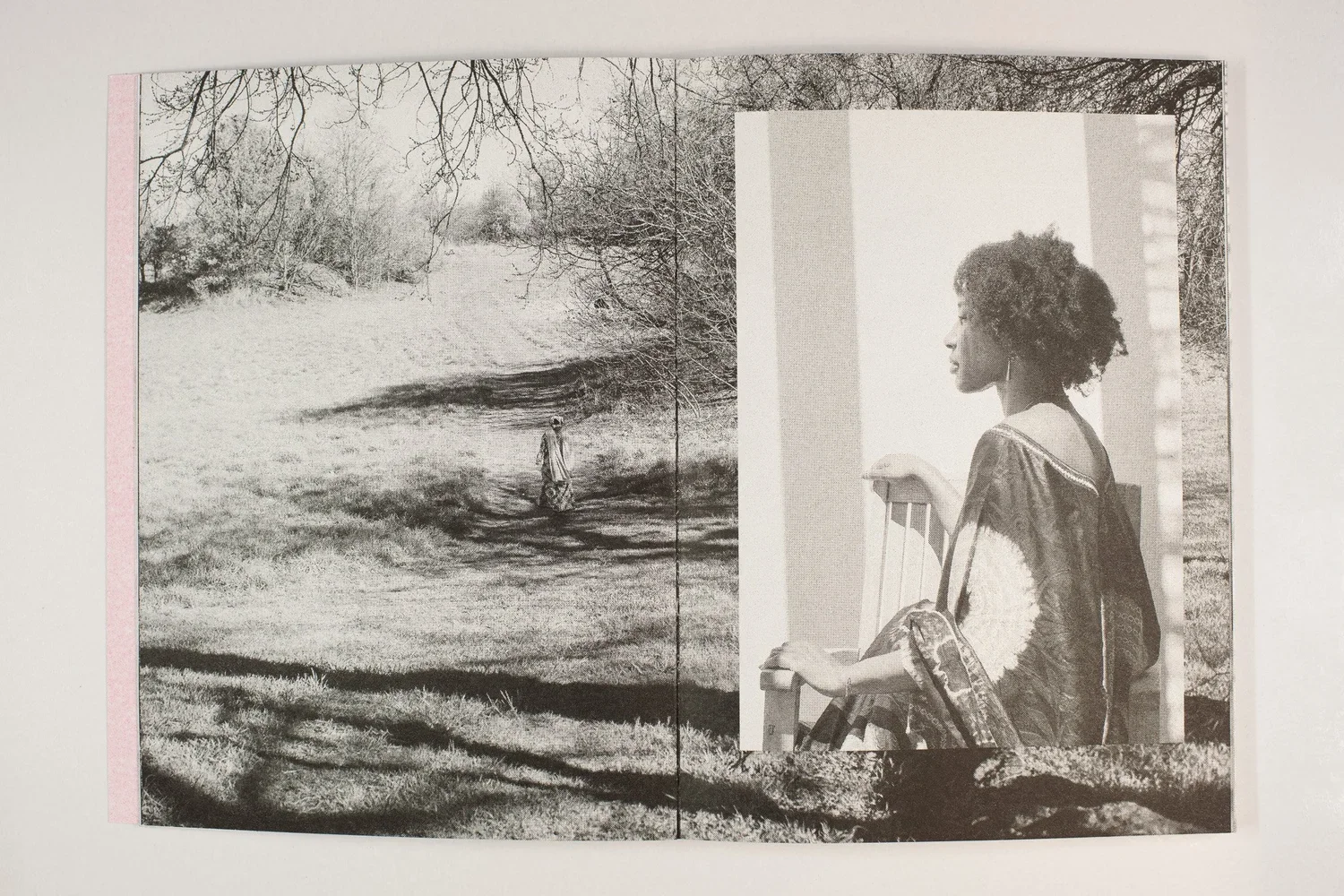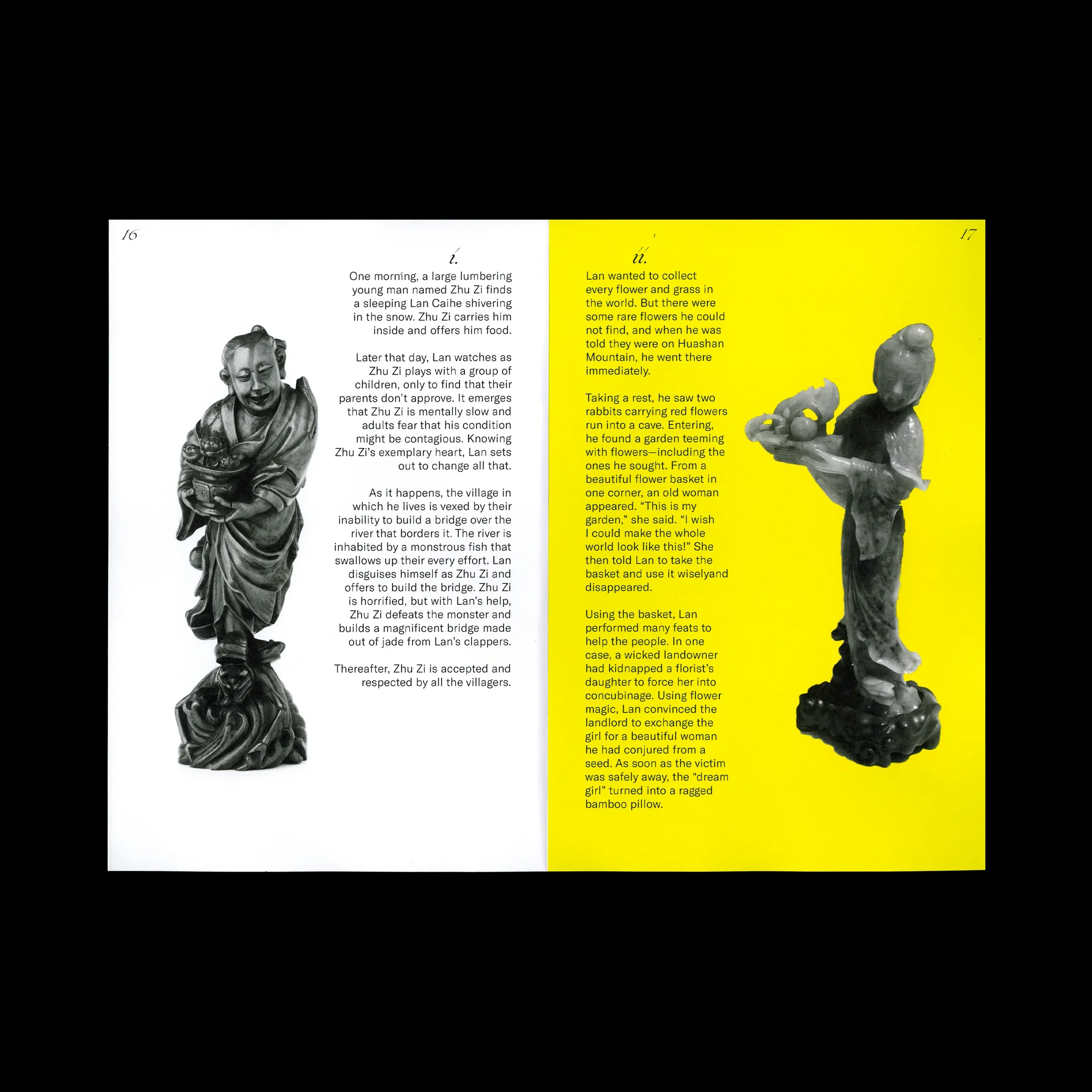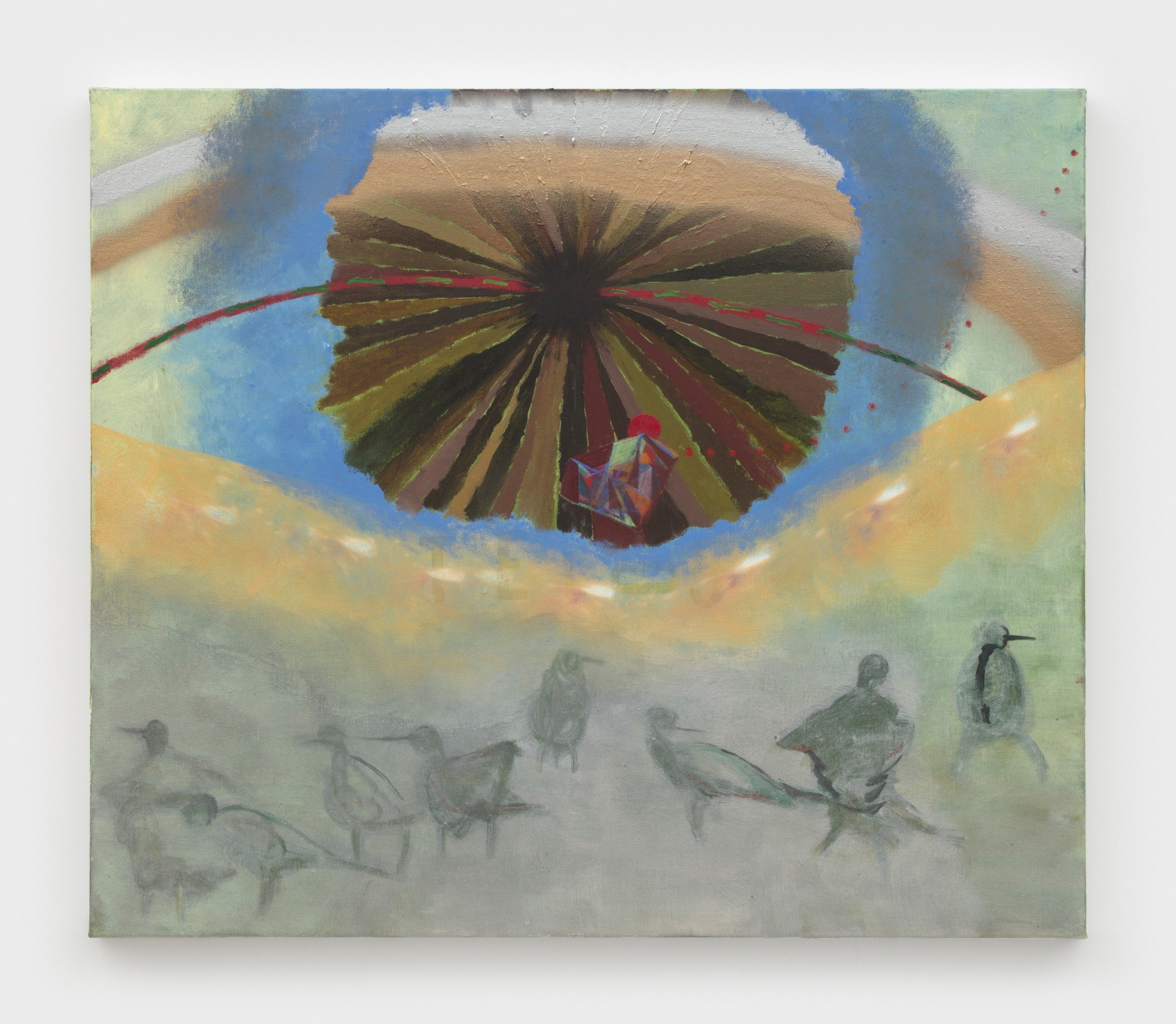Our “library” is an ongoing archive of projects, books, writings, films, research, ideas, exhibitions, installations, performances, workshops, teachings, songs, documents, spaces, activations, etc created by former residents. Please enjoy.
Performance / Scrolling
Carmen Ixchel Maya (CDMX) Resident, 2025
Scrolling, a performance cheorographed & produced by 2024 resident Carmen Ixchel Maya, investigates the relationship between human behavior and the way that our bodies adopt social media / digital images which subsequently become part of the formation of our identities. The project observes the gestures and ways of speaking and moving that we develop through our experience with screens and the process in which these experiences are absorbed by our bodies. As our bodies make these images their own, we try to imitate them and based on them we build our individual subjectivity, belonging & identity.
Photobook / I am (Not) Your Mother
Hady Barry (Côte d’Ivoire) Resident, 2025
At 13, Hady Barry became responsible for the care of my three younger siblings, the youngest of whom was only seven after fleeing the civil war in Côte d’Ivoire and arriving in Senegal, after which her mother left for the U.S. to seek asylum for herself and for the family.
“i am (not) your mother is a confrontation of the trauma I experienced during my teenage years and how it continues to shape my relationship with my mother. It is an attempt to process the complex feelings I have towards her —an unsteady mix of hurt, resentment, admiration, and love. The work interweaves documentary photography, archival family images, journal entries, and transcribed conversations with my mother.”
Music/ Lose Sight
Nica Sabet (London) Resident, 2025
The lyrics of LOSE SIGHT, the most recent release by musician & architect, Nica Sabet, are inspired by a poem 'Of Falconry' by St John of the Cross.
“A song about hope and faith in times of doubt and darkness, the ending of 'LOSE SIGHT' pays tribute to 10 Bahai women who were executed in a single night in the city of Shiraz, 40 years ago. Their crime was a refusal to renounce their beliefs in a faith that promotes gender equality, unity, justice, and truthfulness. Today their legacy continues through countless young women in Iran who continue to fight for equality.”
Visual Investigation / On the Same Boat: The Heavy Sail
Velvet Zoe Ramos (Aruba) Resident, 2025
‘On the Same Boat” is an ongoing project by Velvet Zoe Ramos. This particular iteration, The Heavy sail is built by handmade salt flat bread and found objects addresses the instability of food (bread that disintegrates in water) and access to nourishment by creating “a boat filled with dreams constrained by an expiry date once it sets sail. Lastly, the dried grass that laces the boat like a river or an ocean presents an allegory of an uprooted community, yet still strong, resilient, and regenerating.”
Publication / Legends Zine
Rey Carlson (New York, NY) Sur o No Sur, 2025
Legends is a publication exploring the historical roots of queerness in Chinese culture, as well as its mythical creatures and stories. This book serves as evidence that queerness has and always will exist, and the exploration of mythical creatures is a reminder for the artist, they have access to means of educating themselves on the culture that was not always taught from family. This publication is for queer people, for Asian people, for those who feel like imposters or feel fake.
Film / Video Dance / Peregrina
Mirna Gómez Silva + Raymundo Pavón Lozano (Xalapa, Mexico) Casa Abierta, 2025
Dancer Mirna Gómez Silva and son jarocho musician Raymundo Pavón Lozano have been working together since 2020. Peregrina, a continuing collaboration, is an interdisciplinary choreographic piece paying homage to the fragmented memories of an ancestral past, navigating the cycles of life, death, and rebirth. The landscapes, drawn with the sound of the jarana, a symbol of Son Jarocho, act as a bridge between the present and the spirit of past existences as La Peregrina, the main character, seeks to redefine her present and give thanks for what came before.
Film / Lotus Flowers
Yin Yin Wong (Rotterdam, Netherlands) Resident, 2024
“In this short film, I ask my mother to teach me how to fold the lotus flower napkins that we used to have on our restaurant table setting. During the folding tutorial, we talk about different connotations surrounding the lotus flower and memories of our restaurant Choong Kee. In the film I ask her whether she as ever seen a lotus flower in real life. She answers that she has seen them in Malaysia, in the wild. She followed that wild lotus flowers should never be picked, as those who try get caught in the surrounding quicksand and drown. In this I heard a metaphor for the diasporic experience - many Asian families venture to the West in search of a better life, only to get stuck with no way back.”
Visual Investigation / Greetings from Chicagoacán
Leticia Pardo (Chicago, IL) Resident, 2021
“How does longing manifest in the built environment? Through mold-making and casting, I document products found in American supermarkets that connect me to home.
An ongoing project composed of many parts, Greetings from Chicagoacán documents different ways of place-making by the Mexican community in Chicago.”
Film / Huella
Gabriela Ortega (Los Angeles, CA) Resident 2022
“When the death of her grandmother unleashes a generational curse, a disenchanted flamenco dancer resigned to a desk job is forced to experience the five stages of grief through a visit from her female ancestors, pushing her to finally break the cycle.”
Exhibition / Rhizome St. / Fugue Avenue at P·P·O·W
mosie romney (Brooklyn, NY) Resident 2021
“Working in the space between figuration and abstraction, romney uses painting as a portal through which to explore themes of self-perception and polychronic time. Often beginning with collage, romney stages fantasy worlds that disrupt our notions of reality, memory, and symbolic order. An introduction to a new body of work, Rhizome St. / Fugue Avenue immerses the viewer in an imaginary place of both rupture and renewal. With a new cast of characters, romney envisions the psychology of alienation and placelessness, taking the viewer on a flight of the unreasonable towards spiritual transformation.”
Film / el baile de las ánimas
Ramón Llaven (Oaxaca, MX) Resident 2024
“Inspired by the traditions of the Day of the Dead that he’s known since childhood in his native Santiago Etla, this documentary follows the stories of four people and their relationship with death. The Day of the Dead celebrations, which for two years were suspended or restricted due to the Covid-19 pandemic, are also part of the documentary. ‘It has to do with this process of waiting for these celebrations to be allowed, because due to the pandemic [the festivities] were not authorized, and I didn’t have an image that could reflect them,’ explains Ramon, who began the script in 2019.”
Virtual Reality / The Abyssinian Cyber Vernaculus
Miriam Hilawi (Addis Ababa, Ethiopia) Resident 2023
“The Abyssinian Cyber Vernaculus is a series of visual narratives that unfold over the rock-hewn churches of Lalibela, Ethiopia. Using methods of virtual immersion and narrative mythmaking, this work seeks to uncover and reinstate the presence of those marginalized and maligned by the dominant conservative ethos of contemporary Ethiopian society, while pushing up against the apocryphal stories of Africa.”
Research Guide / Beyoncé’s Lemonade and Information Resources
Jennifer Ferretti (Baltimore, MD) Resident 2020
“After Beyoncé’s visual album Lemonade aired on HBO on Saturday, April 23, 2016, I developed this research guide in an attempt to investigate the hour and five minutes of music, poetry, references to history, literature, and art included in this production. Art is full of information and it rarely lands in an artists’ lap. Artists participate in the iterative process of research, organizing, analyzing, and remixing of information. ..This guide supports further research into Beyoncé's literary, film, and history references in her visual album 'Lemonade.'“
Textile / 5.4 Million and Counting
Chi Nguyen (Brooklyn, NY) Resident 2016
“A community quilt in response to numerous restrictions that could shut down nearly all abortion clinics in Texas and prevent 5.4 million women of reproductive age from accessing the healthcare they need. As the case Whole Woman’s Health v. Hellerstedt headed to the Supreme Court in March 2016, artist Chi Nguyen — in partnership with the Textile Arts Center and the Center for Reproductive Rights — held a series of stitch-ins to make physical the number of women whose right to safe and legal abortion is currently at risk. With over 1100 participants from 36 states and 9 countries, the largest quilt to protect abortion access was created and held up in front of the Supreme Court during the Oral Argument in March and Decision Day in June, 2016.”
Album / Mayahuel by Savila
Fabiola Reyna & Brisa Gonzalez (Portland, OR) Residents 2019
“Sávila is a cumbia/latin/world/r&b inspired music and visual art project by guitarist Fabiola Reyna, vocalist Brisa Gonzalez and percussionist extraordinaire Papi Fimbres. MAYAHUEL [initiated during their residency!] is the follow up to their self-titled debut LP and further explores Sávila's singular melding of cumbia, dream-pop, spirited vocals, hallucinatory riffing and driving percussion.”
“MAYAHUEL is based on time spent before the pandemic immersed in the music, traditions, people and environment of that beautiful place. Lots of these songs are integrated with field recordings from musicians we met along the way, incorporating pre-hispanic percussion elements and field recordings taken from the streets during our time there. Meant more as a reflection on what we encountered though some songs evolved into something more elaborate as we explore the genre of ancestral club. Music for our ancestors made for the club.”- Sávila
Mixed Media / the war that ripened
Sarah Hakani (Brooklyn, NY) Resident 2024
Sarah Hakani’s the war that ripened (Mixed media, 2020) is part of American Muslim Futures, a project inviting artists to respond to liberation, both actual and imagined, for themselves and for others. “Collaging images that were generated by running the poetry of Mahmoud Darwish through a broken neural network, Sarah’s work literally and figuratively reinterprets Darwish’s line, ‘Do not regret the war that ripened you, just as August ripens pomegranates on the slopes of stolen mountains.’”
Novel / Home Making
Lee Matalone (Richmond, VA) Resident 2019
“From a talented, powerful new voice in fiction comes a stunning novel about the intersection of three Southerners’ lives coming to grips with identity, family legacy, and what it means to make a house a true home….Through each of [her] characters Matalone weaves a moving, beautiful narrative of home, identity, and belonging. Home Making is a somber, yet hopeful, ode to the stories we tell ourselves in order to make a family.”
Film Program / MAKA Many Eyed Vessels
Isabel Rojas / co-curator (Oaxaca, MX) Resident 2024
“With this… program, we invite you to visualize the opening of a net. Like a net, each offering and film in this program acts as a knot. Each knot is tied together by the same throughlines and threads, creating a collectively woven container. Nets carry the things that sustain us, with this program, we seek to nourish from within. Bringing together artists from around the world, this program is a curated response to the 2022 Flaherty Seminar and the stirring reverberations that followed. With the intention of nourishment, MAKA: Many Eyed Vessel reckons with the themes of its predecessor while navigating institutional spaces through its offerings of reflection, interconnection, and the future.”
Collection / Colección Margarita Robles
Miguel / Margarita Cinta Robles (Oaxaca, MX) Resident 2023
The ever-growing Colección Margarita Robles — named after Miguel's grandmother and frequent pseudonym — is a collection of natural objects encountered on his long walks. As described in his 2022 exhibition (seen above), the various objects in the collection “weave aesthetic relationships between them, as well as … between their characteristics and the experiences that viewers generate in relation to them.” The collection contradicts “ethnobotanical collections motivated by extractivism and instead confronts violent collecting with a collection created from the loving, affective walk of the hills and landscapes. Made up of taking gently and preserving, based on the principles of asking permission, borrowing, collecting carefully.”
Newsletter / The Neverending Dinner Party
Saehee Cho (Los Angeles, CA) Resident 2019
Saehee’s work investigating the Korean-Mexican diaspora takes many forms. Here, she brings together “a recipe journal, a home for on-going travel writing & general musings, and a record of conversations with people doing good things in the food world and beyond – an extension and archive of our table.”
Newsletter / The Land is Holy
Noam Keim (Philadelphia, PA) Resident 2022
“The Land is Holy and so are you”
Performance / Metabolizing the Border
Tanya Aguiñiga (Los Angeles, CA) Resident 2022
“Through performative wearables made of blown glass embedded with border fence remnants, Metabolizing the Border explores how the body confronts fragments of the border fence through sight, sound, smell, taste, and tactility. The sandals are modeled after tire-soled huaraches that rural and Indigenous people wear in Mexico and Central America. They are sculpted in glass to represent the struggle migrants face when arriving in the U.S. of not being supported enough to succeed in society, and are designed to fail and to make more difficult a wearers’ journey. These glass prosthetics represent a radical shift in my work methodology and materials, bringing my 20-plus years of work on the border to an acute focus on the corporeal experience of borders. With this new series I aim to give a larger platform to the emotional and psychological effects that a border wall has on those living on the border.”
Exhibition / Siempreviva at Casa del Lago UNAM
Alan Hernández (Oaxaca, MX) Resident 2020
"Hernández's work combines the technique of textile embroidery and blacksmithing, his parents trades, from which he takes influence to create detailed hanging sculptures with organic shapes that allude to flora and fauna. His creations are always intertwined with his personal history; On the wings of a black moth that portends a tragedy are fragments of clothing from its deceased relatives, corn beads darned to the voluptuous breasts of a mutant being refer to the agricultural past of its ancestors. The title of the exhibition, Siempreviva, takes the name of the species of perennial plants that have special resistance to adverse landscapes, to pay tribute to the maternal figure, symbol of fertility and sustenance of life. An exhibition that thematically addresses the duality of life and death, in which the entities created by the author shine with exuberance suspended in the midst of darkness.”
Exhibition / Limbs, at Hesse Flatow
Devra Fox (San Francisco, CA) Resident 2017
“Rendered with hyper-realistic precision, Devra Fox’s graphite drawings of anthropomorphized plant forms muse on notions of containment outside of the body. In seamlessly grafting anatomical features like spinal vertebrae or arterial chambers with vegetal offshoots, she extends the metaphor of the vessel beyond the somatic. Thoughts, memories, and emotions are embodied and compartmentalized into spliced forms, creating equivalencies between cellular renewal and psychological repair.”
Visual Investigation / Layú biza’bi (Tierra prometida)
Dell Alvarado (Oaxaca, MX) Resident 2022
"Layú biza’bi is the reconstruction of territory based on artistic research. I view it as a process to reflect on the social fabric from the perspective of collectivity, resistance and sense of belonging to the territory and my Zapotec language. Creating — from earth pigments from different points of Unión Hidalgo in the Isthmus of Tehuantepec — a pictorial language to discuss with the community about the geostrategic dispossession that foreign companies are carrying out in the territory and proposing drawing as an approach to the territory and a study of painting through cartography, mapping and archiving.
Layú biza'bi is a dialogue between land and territory.”
Installation / CHOLO – CHOLA
Ivan Sikic (Lima, Peru) Resident 2022
“CHOLO – CHOLA (2019 - 2022) is a site specific installation located on a broken up sand dune 105KM south of Lima. This work uses language as a mirror, confronting the viewer with words that can carry multiple meanings that encapsulate discrimination and division, as well as pride and empowerment, but that also act as a reminder to Peruvians of the Racist undertones present in our society. With this in mind, the words Cholo and Chola have been drawn with 10 meter tall x 6 meter wide letters in the middle of the deserted Peruvian coast, on the sides of a road that is mostly used during the summer months (January - March), in a location known and accused of racist and discriminatory practices within its protected and fenced off communities: the private beaches of the Asia district, which extends for about 15 - 20 kilometers along the Pacific Ocean.”
NGO / UNA MANO PARA OAXACA
Perseida Tenorio (Ixtaltepec, Oaxaca) Resident 2024
“We are a collective of young women that promotes the preservation of local knowledge and traditional crafts as a basis for building sustainable livelihoods, among people of different ages, to regenerate the social fabric and links with our territory, as a defense of cultural rights. for a fair and equal present. Our dream is to knit ourselves together again as a community through our own hands.”
Installation / Low-Tech Paper Pulp Lab
Ana Rita Antonio (Lisbon, Portugal) Resident 2019
“The participatory installation Low-tech paper pulp lab aims at bringing people together to collaborate with the artists in a commodity chain performance designed for recycling and upcycling paper. The recycling laboratory was designed like a “kitchen studio”, including different work stations, such as collecting, sorting, shredding, pulping, de-inking, drying, and modeling the paper. It is up to the participants to decide in which part of the chain they wish to contribute and participate, as well as which object they desire to create as the final outcome of their participation. The Low-tech paper pulp lab is assembled through a modular system designed under a grid available for free on an online platform in which creatives from around the world contribute with the design of parts, allowing the structure to be organically re-arranged and adapted to diverse purposes. What is a paper pulp lab today may be a greenhouse or a shelter structure tomorrow.”
Installation / A Tale of Two Citites (From Oaxaca City to Baltimore City)
Krystal Mack (Baltimore, MD) Resident 2020
“Inspired by Mexican ofrendas and Danish still-life paintings, “A Tale of Two Cities (from Oaxaca City to Baltimore City)” honors the shared decolonization struggle of two very different yet similar cities, Oaxaca City and Baltimore. On this table are comestibles that play positive, negative, and neutral roles in the decolonization of food systems for both Oaxaca City and Baltimore. Foods with complicated histories in Mexico like mezcal, pastries, and peanuts are positioned alongside American foods with violent pasts such as fried chicken. Krystal created and presented this work as a research resident at Pocoapoco in January 2020. As with all of Krystal’s comestible tablescapes, visitors of the Pocoapoco open house were allowed to graze and participate in a comestible cultural exchange.”
Book / Cooking as Though You Might Cook Again
Daniel Licht (New York) Resident 2019
“To cook or not to cook: it is a new question in history. In the age of supermarket buffets and liquid meal replacements, cooking at home has never made less sense. Cooking has become a luxury on the one hand and a chore on the other, and it is both of these too much, and it is neither one quite enough, and it has made me wonder, against the odds, against reason, and against common sense: what exactly is cooking for?”

























